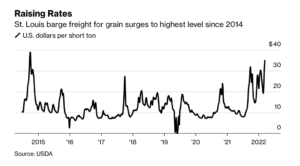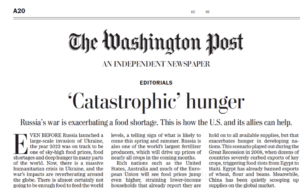China has bought at least 8 million tons of US soybeans this year, according to people familiar with the matter, putting the world’s top importer on track to meet a…
Fertilizer Prices Hit New Highs, as Russian Invasion “Exacerbating a Food Shortage”
Bloomberg writer Elizabeth Elkin reported yesterday that, “Fertilizer prices continue to surge to records as Russia’s invasion of Ukraine puts a massive portion of the world’s fertilizer supply at risk, adding to concerns over soaring global food inflation.

“The Green Markets North America Fertilizer Price Index jumped almost 10% Friday to an all-time high as the market worries that potential sanctions on Russia, a big low-cost shipper of every major kind of crop nutrient, could disrupt global trade. The country accounted for almost a fifth of 2021 fertilizer exports, according to Trade Data Monitor and Bloomberg’s Green Markets.”
Elkin added that, “Russia has urged domestic fertilizer producers to reduce exports, further stoking fears of shortages. The war also is pushing up the cost of natural gas, the main input for most nitrogen fertilizer, forcing some producers in Europe to cut output.”
In a separate article yesterday, Elkin reported that, “Nutrien Ltd., the world’s largest fertilizer company, wants to expand its retail footprint in agricultural powerhouse Brazil.”
“The company would ‘love’ to do more mergers and acquisitions, [Interim Chief Executive Officer Ken Seitz] said in an interview, and further deals in Brazil will be the focus,” the Bloomberg article said.
With respect to commodity market prices, Reuters writer Tom Polansek reported yesterday that, “U.S. grain and soybean futures eased on Friday as traders monitored diplomatic efforts to end Russia’s invasion of Ukraine and gauged continuing disruptions to Black Sea crop exports.”
“Grain prices have been volatile since the invasion, as importers are heavily reliant on supplies shipped from Russia and Ukraine through the Black Sea,” the Reuters article said.

Also yesterday, Bloomberg writers Megan Durisin and Allison Nicole Smith reported that, “Wheat and corn slid in Chicago, closing out a back-and-forth week for prices as the war in Ukraine leaves traders parsing an increasingly unclear supply outlook.”
Durisin and Smith noted that, “[Ukraine’s ] spring sowing period is also fast approaching, crucial to determine the coming corn and sunflower crops. Growers will plant as much as possible, although yields may fall by a quarter, according to Agriculture Minister Roman Leshchenko. Farmers are facing damaged infrastructure and shortages of fuel and other inputs.”
In related news, Bloomberg writers Michael Hirtzer and Dominic Carey reported yesterday that, “War in Ukraine and drought in Brazil have global crop importers turning to the U.S., and the pivot means costs to ship grains and soybeans on the Mississippi River have soared to an almost eight-year high.”

In other developments, Reuters writers Gavin Jones and Cristiano Corvino reported yesterday that, “Carlo Vittorio Ferrari, who runs a farm holding 2,000 pigs with his brother near the town of Cremona in northern Italy, fears his fourth generation family business could be lost due to conflict in Ukraine.
“The country is a major global supplier of animal feed, stocks of which are falling fast across import-reliant southern Europe.
With Hungary, Serbia and Moldova also banning exports as they safeguard their own supplies, costs for farms like Ferrari’s have spiked, threatening their future. Many face culling animals if the situation doesn’t improve quickly.
And The Washington Post editorial board opined in yesterday’s paper that, “Even before Russia launched a large-scale invasion of Ukraine, the year 2022 was on track to be one of sky-high food prices, food shortages and deep hunger in many parts of the world. Now, there is a massive humanitarian crisis in Ukraine, and the war’s impacts are reverberating around the globe. There is almost certainly not going to be enough food to feed the world this year. The situation is quickly becoming ‘catastrophic,’ with a high likelihood of famine in parts of the Middle East and Africa, warns the United Nations’ World Food Program.”

The Post editorial indicated that, “In many parts of the developing world, there will be a genuine risk of starvation and famine, because low-income countries do not have enough money to pay high food prices. Fifty countries depend on Russia and Ukraine for more than 30 percent of their wheat, and many are among the poorest nations in North Africa, Asia and the Middle East.”





